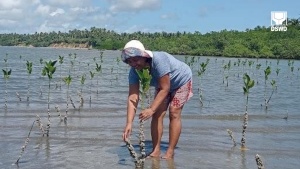
The villagers championed the protection and preservation of mangrove forests in their area to preserve the natural habitat of fish species in their waters, and help prevent soil erosion, and absorb the impacts of storm surges in Barangay Somal-ot.
KALAHI-CIDSS is among the initiatives of the DSWD that highlights the significance of implementing community-driven programs aimed at safeguarding the environment from the effects of climate change.
In the small coastal village of Somal-ot in Casiguran, Sorsogon, community members often experience the brunt of the impacts of weather disturbances.
According to Miraflor Grajo, 57, a barangay councilor of Somal-ot, storms and strong currents pose challenges for community members, especially fisherfolk, in earning a living.
“Dahil sa lahat ng mga nagtatrabaho dito ay nasa dagat, merong minsan walang huli, dahil kung malakas ang ulan, malakas ang alon, hindi nakakapunta ng dagat,” she said.
(Since most of the community members are fisherfolk, there were times when villagers are unable to venture into the sea to fish because of heavy rains and strong waves.)
Recognizing the need to mitigate the effects of hydro-meteorological hazards on the environment and on their livelihood, the villagers banded together to champion the protection and preservation of mangrove forests in their area.
Through the Kapit-Bisig Laban sa Kahirapan Comprehensive and Integrated Delivery of Social Services (KALAHI-CIDSS) of the Department of Social Welfare and Development (DSWD), the community initiated the Cash-for-Work for Mangrove Planting and Declogging of Drainage Canal under the National Community-Driven Development Program – Additional Financing (NCDDP-AF) modality.
KALAHI-CIDSS is a community-driven development program of the DSWD that empowers impoverished municipalities to identify, plan, execute, and oversee community projects targeting local issues.
Maria Teresa Espera, 56, a community volunteer and the chairperson of the Barangay Development Council – Technical Working Group (BDC – TWG), shared that the community prioritized the mangrove planting and declogging of drainage canal for its positive environmental and social impacts to the locals.
“Mangrove dahil nakakatulong po ‘yun sa pagpapadami ng mga isda at mapapakinabangan po paglumaki na sila kahit po may bagyo at maraming malaking alon, maiiwasan pa rin ang pagguho ng lupa sa gilid ng dagat,” she explained.
(We chose mangrove because it helps boost fish stocks and harvests, and helps prevent soil erosion when typhoons or strong waves hit the community.)
However, village leaders admitted that the execution of the sub-project faced a lot of challenges, since not all of the community members were motivated to participate.
Through a series of discussions spearheaded by Teresa, the community was finally convinced of the significance of the project, and was then able to successfully assemble a team of volunteers who will lead in the implementation of the sub-project.
“Sa pakikiusap namin at sa paliwanag namin kung ano naman yung magiging bunga nung paghihirap namin bilang mga volunteer, ‘yan nakukuha naman namin ang loob nila para mahikayat ko sila na mag-volunteer,” Teresa shared.
(We managed to convince them after explaining what would be the end-result of our efforts as volunteers.)
United by a common goal to protect their environment, the community members were able to clean drainage canals and planted 6,258 mangrove seedlings, benefiting 49 households at a total project cost of Php161,790.
Teresa also shared that her volunteerism can be compared as a chili plant, in which despite the spiciness, it will serve as a part of the learning process.
“Parang ganun ang naging buhay ko na paunti-unti nagiging maganda at sa bandang huli, kahit maanghang, masarap pa rin,” she shared with a smile.
(The chili plant is similar to my life wherein it gradually became a wonderful life, and even though it’s spicy, it’s still good.)
As the mangroves continue to thrive in the small coastal community, they now become a symbol of resilience and empowerment of Barangay Somal-ot and its volunteers, promising a greener future for the villagers.
The KALAHI-CIDSS is among the initiatives of the DSWD that highlights the significance of implementing programs aimed at safeguarding the environment from the effects of climate change.
As of December 2023, there are already 16,994 completed KALAHI-CIDSS community projects under the NCDDP-AF modality which have benefited more than 6.4 million households in the country. #


